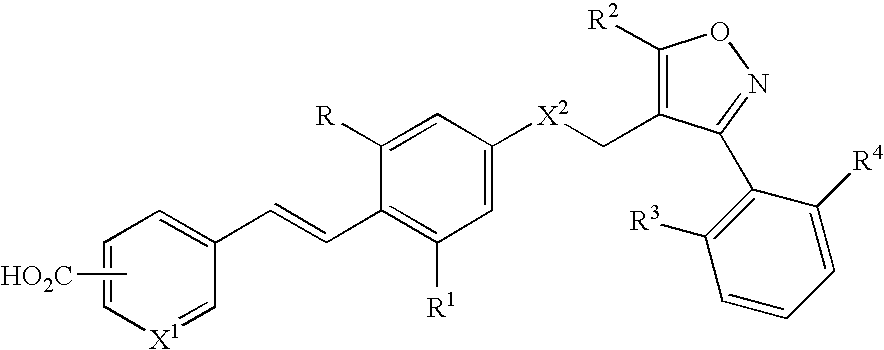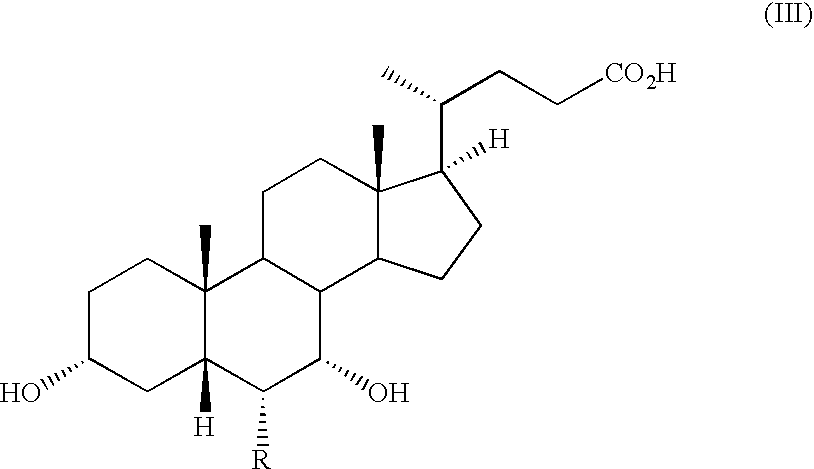Methods of using farnesoid x receptor (frx) agonists
a technology of x receptor and agonist, which is applied in the field of farnesoid x receptor (fxr) agonists, can solve the problems of overweight individuals, difficult to successfully lose weight, and substantial increase in the risk of morbidity and mortality of overweight individuals, so as to achieve increased leptin release and increase the effect of leptin releas
- Summary
- Abstract
- Description
- Claims
- Application Information
AI Technical Summary
Benefits of technology
Problems solved by technology
Method used
Image
Examples
example 1
Differential Expression of FGF19 in Human Hepatocytes Treated with FXR Agonists
[0045] The pattern of gene expression induced in human hepatocytes after treatment with an FXR ligand was measured.
Materials and Methods
[0046] Nine samples of human hepatocytes were used: Human hepatocytes treated with DMSO control (3 samples), human hepatocytes treated with chenodeoxycholic acid (CDCA; 3 samples), and human hepatocytes treated with FXR agonist GW4064X (3 samples). RNA was extracted from the cells and gene expression analysis was performed by CuraGen Corporation (New Haven, Conn.) using transcript profiling technology as described above. See Nat Biotechnol 17:798-803, 1999; see also U.S. Pat. Nos. 5,871,697 and 5,972,693.
[0047] Three independent reactions from each cDNA sample were compared for quality of electrophoretic peak resolution and reproducibility of peak patterns. Composite traces from each sample were generated, and then compared among the three independent samples for pea...
example 2
Effect of FXR Agonist on Leptin Release from Adipocytes In Vitro
[0050] The addition of recombinant human FGF-19 to cultures of primary rat adipocytes is reported to increase the release of leptin from the cells (WO 0118210). As noted in Example 1, herein, expression of human Fibroblast Growth Factor 19 (hFGF19) was increased in human hepatocytes treated with FXR agonist compounds, compared to control cells.
[0051] The present study investigates the use of an FXR agonist to induce expression of FGF-19 in liver cells. Increased secretion of the hFGF19 protein can thereby increase the release of leptin from adipocytes.
[0052] Cultures of rat adipocytes are established using any suitable means as is known in the art. One suitable method harvests fibroblastic preadipocytes from the inguinal fat deposit of sucking rats, which are then cultured and induced to differentiate into mature adipocytes. Following differentiation, the ob (leptin) gene is expressed and leptin is secreted into the ...
example 3
Effect of FXR Agonist on Glucose Uptake by Adipocytes In Vitro
[0055] The addition of recombinant human FGF-19 to cultures of primary rat adipocytes has been reported to decrease the uptake of glucose (WO 0118210). The present study investigates the use of an FXR agonist to induce expression of FGF-19 in liver cells, and the effect of hFGF19 protein on the uptake of glucose by rat white adipocytes.
[0056] Cultures of primary rat adipocytes and human liver cells are established using any suitable means as is known in the art, as discussed above.
[0057] An FXR agonist is added to liver cell cultures (primary human hepatocytes or HuH7 cells) to induce expression and secretion of FGF19. Control liver cell cultures (without exposure to FXR agonist) are also prepared. Suitable FXR agonists include compounds of Formulas I-III as described herein. Conditioned media obtained from the liver cell cultures exposed to FXR agonist (and control medium) are then added to adipocyte cell cultures in ...
PUM
| Property | Measurement | Unit |
|---|---|---|
| weight | aaaaa | aaaaa |
| weight loss | aaaaa | aaaaa |
| total body mass | aaaaa | aaaaa |
Abstract
Description
Claims
Application Information
 Login to View More
Login to View More - R&D
- Intellectual Property
- Life Sciences
- Materials
- Tech Scout
- Unparalleled Data Quality
- Higher Quality Content
- 60% Fewer Hallucinations
Browse by: Latest US Patents, China's latest patents, Technical Efficacy Thesaurus, Application Domain, Technology Topic, Popular Technical Reports.
© 2025 PatSnap. All rights reserved.Legal|Privacy policy|Modern Slavery Act Transparency Statement|Sitemap|About US| Contact US: help@patsnap.com



